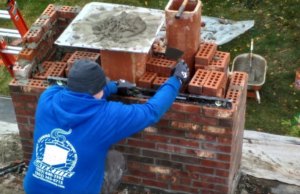Masonry Repair Long Island is a construction method that uses bricks or stones bound together with cement mortar. Over time, these structures may suffer from a variety of issues that can affect the integrity and appearance of buildings.
Repairing and restoration methods are based on conditions identified, project budgets and schedules, durability expectations and preservation goals. Treatment options may include tuck pointing with specialist mortars, stone repair or crack injection.

The damage caused by water is one of the most common issues that require masonry repair. The mortar that holds bricks and stones together must be able to absorb water and release it without being damaged or becoming saturated with moisture. Otherwise, the masonry will begin to deteriorate and may eventually break apart. This problem can be especially serious in older buildings, where the ground beneath the building has settled or shifted. In such cases, the water seeps into the masonry and then freezes when the temperature drops, expanding the cracks in the masonry. This can lead to structural damage and safety hazards.
When a masonry structure is affected by water damage, the first sign is usually staining of the brickwork. This is a clear indication that the water has caused some form of deterioration and must be addressed immediately. Staining can also indicate a structural issue called displacement, which occurs when the masonry shifts and no longer rests in its proper position. This is a serious issue that must be repaired immediately by a professional mason.
Masonry repair often involves repairing cracked or crumbling bricks, repointing the mortar between them, and painting with a waterproof coating that is breathable. The goal is to keep moisture from damaging the masonry, while keeping the structure in good shape for years to come. If a masonry structure is in need of restoration, however, that is a much more extensive project that aims to bring the structure back to its original state.
Regular inspections by a qualified mason are a great way to catch problems before they become severe and expensive. It is important to inspect all of the masonry in your building at least twice per year, particularly after periods of heavy rain or other weather conditions that could affect the condition of the masonry. A mason will be able to identify any areas that need repair and recommend the correct course of action. This can prevent minor damage from turning into a major repair bill down the line, and can also protect your property and ensure its safety for years to come.
Cracked Bricks
Brick is a very durable material, but cracks in brick walls can indicate serious problems and may require immediate masonry repair. Brick cracks are often caused by temperature changes and structural shifting, but it is also common for masonry to be affected by weather conditions like freeze and thaw cycles. Brick can also be damaged by water infiltration due to deficient mortar joints or from leaking gutters and pipes.
When a crack appears in your brick wall, the first thing to do is look for a pattern. Is the crack running vertically, horizontally, or diagonally? Horizontal brick cracks are the most dangerous type of wall damage. They are a sign that the foundation is actually failing and will soon collapse if not repaired immediately. If the cracks are not horizontal but instead run through a portion of a stair step or other area, they may be caused by a thermal expansion issue in which case a professional mason should be called to assess the situation and make recommendations for remediation.
Cracks that are a part of a pattern are less serious but still should be addressed as soon as possible. This type of crack can be a result of water infiltration through deficient mortar joints, or from erosion in the surrounding soil which is pushing against brick and other masonry walls. The presence of vines or other greenery growing through brick walls can also put pressure on the brick, especially if you attempt to remove the greenery by pulling at it.
If you find that you have horizontal brick cracks near the steel beams in a concrete foundation, this could be a sign of oxide jacking, which occurs when corroded steel pushes up against brick and other masonry structures. This type of cracking is extremely dangerous and requires emergency masonry repair services.
In most cases, repairing cracks in brick is a fairly simple and affordable process. Small cracks can be fixed with a hammer, chisel and brush, and a bonding agent, while larger areas of damage are typically referred to a mason for inspection and repairs. When a mason inspects and evaluates the brick damage, they can advise you of the cost of repair based on the specific situation and the extent of the work required.
Efflorescence
When building managers notice the chalky white crystalline residue known as efflorescence on the walls of a brick or other porous building material, it is a sign of moisture problems that must be dealt with immediately. This problem is caused when water – whether from rain, groundwater or the water used in construction – seeps through the material and evaporates, leaving behind salt deposits on the surface. Efflorescence can occur on brick, stone, concrete, paving stones and stucco. It is also common on basement walls in moist environments. Although it is not harmful, the build-up of salts weakens materials from within and can cause structural damage, including spalling or crumbling.
Masonry structures are generally durable and strong, but they need to be properly maintained and cared for in order to avoid deterioration. Fortunately, masonry repair and restoration services can help prevent deterioration by addressing minor damages to the structure and restoring its historical integrity. Both repairs and restorations involve the work of masonry contractors, but restorations are often more extensive projects that require a higher level of professional expertise and knowledge.
Before performing a masonry repair, it is essential to understand the difference between repairs and restorations so that you know what kind of work to expect. A reputable contractor should be able to provide references and examples of previous projects to give you a good idea of the quality of their work. They should also be able to answer any questions you may have about the different types of work they offer and how they might best suit your needs.
Efflorescence can be removed by washing the affected area with pressurized water. In some cases, a chemical such as muriatic acid may be used to dissolve the deposits. This can be a very dangerous process, and it is important that the mason you hire has experience handling this type of chemical. Baking soda should be used to neutralize the acid after it is applied in order to protect the underlying masonry from discoloration or further damage.
The most effective way to keep efflorescence at bay is to prevent the water from entering the masonry in the first place. To do this, building materials should be kept dry during construction and renovation projects. It is recommended that bricks be stored on pallets instead of directly on the ground and that capillary breaks – such as polyethelene sheeting – are installed to prevent moisture from absorbing into masonry walls.
Cracked Stone
Masonry is an incredibly durable material, but it can still experience some damage over time. If your building’s masonry is showing signs of aging, it is important to have it repaired by a professional commercial masonry contractor soon. The longer you wait, the more likely it is that the masonry will need to be restored later on, which can be an even bigger and more expensive project.
Some common signs that your masonry needs repair include cracks in the bricks and crumbling mortar. These issues can cause serious structural problems for your building if left untreated, so it’s important to contact a masonry restoration specialist as soon as you notice any of these symptoms.
The good news is that masonry repair can fix many types of brick and stone issues. A masonry repair company can repair cracked bricks, fill in missing mortar, and even replace damaged bricks or stones to give your structure a new look. They can also restore deteriorated mortar to help prevent further damage and keep your masonry looking its best.
Masonry repair companies can also address issues with your chimney and fireplace if needed. This includes cleaning soot and creosote build-up and repairing any structural problems. They can also handle a variety of other issues that can affect the safety and integrity of your fireplace and chimney, including bird nests, lightning damage, and chimney leaks.
Another problem with old masonry is that it can have fissures in the stone. These are long, narrow cracks that are filled with minerals that are different from those found in the rest of the rock. While they may be unsightly, fissures in masonry are not usually a sign of structural problems.
When you’re planning a masonry project, it’s a good idea to purchase some of the supplies you’ll need before you start working. This will save you money and make the project go smoother. At Lowe’s, we carry a wide variety of masonry supplies, including ready-mix concrete, standard cement mix, and rebar for projects like concrete slabs and sidewalks. We also offer a variety of masonry tools and accessories, including cutters, pliers, and rebar ties.



